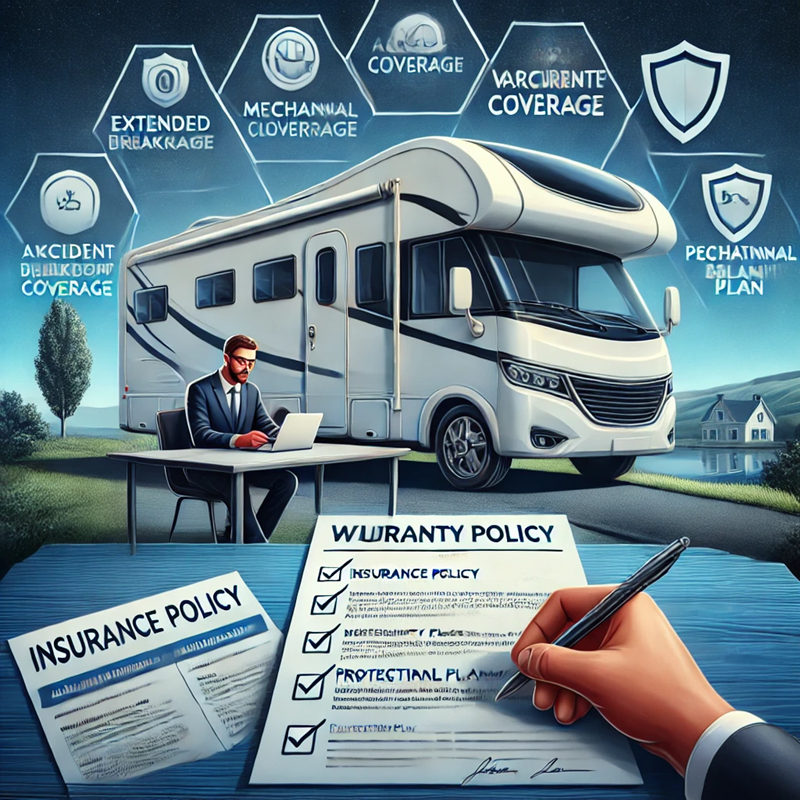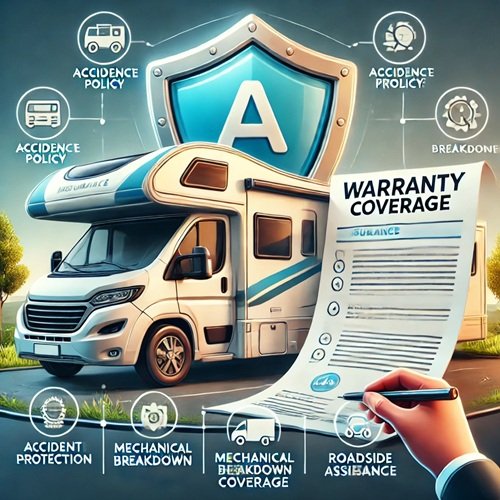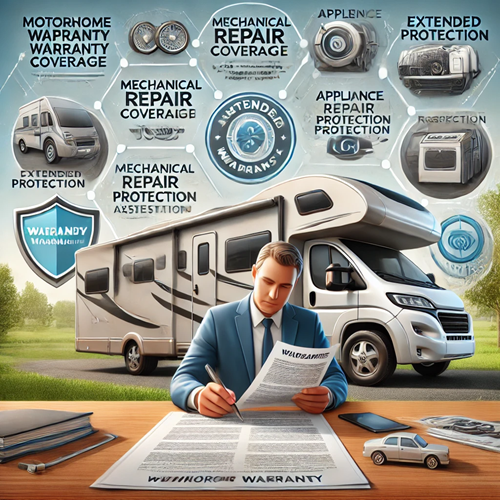Buying a motorhome is an exciting investment that requires careful planning to ensure you make the right choice. Over the course of this series, we have covered essential steps to guide you through the purchasing process. Let’s take a moment to reflect on what we have covered so far before delving into Step Seven: Considering Insurance and Warranty Options.
In Step One, we focused on determining a budget that includes not just the purchase price but also ongoing expenses such as insurance, maintenance, and fuel. Step Two emphasized the importance of assessing your travel needs to ensure you choose a motorhome that aligns with your lifestyle and comfort requirements.
Moving forward, Step Three explored different motorhome types, from the luxurious Class A models to the compact campervans, helping you understand which type suits your preferences. Step Four guided you through the decision between purchasing a new or used motorhome, weighing factors such as depreciation, warranty coverage, and upfront costs.
In Step Five, we highlighted the importance of thoroughly inspecting and test-driving a motorhome before purchase, checking the engine, plumbing, appliances, and overall structural integrity. Step Six then emphasized the need to review a used motorhome’s history, examining service records, accident reports, and past ownership details to avoid potential red flags.

With these crucial steps behind us, it is now time to explore Step Seven: Understanding insurance and warranty options. This step ensures that your investment is protected from unexpected costs and issues that may arise during ownership.
Why Insurance and Warranty Coverage Matter?
Owning a motorhome comes with inherent risks, such as breakdowns, accidents, theft, and weather damage. Having the right insurance and warranty coverage can safeguard you from significant financial losses and provide peace of mind while traveling.
Motorhome insurance differs from standard car insurance due to the unique risks associated with recreational vehicles. There are different types of insurance policies available depending on how you intend to use your motorhome. Comprehensive insurance provides coverage for damage caused by accidents, fire, theft, vandalism, and natural disasters. Third-party insurance covers damage caused to other people’s vehicles or property but does not cover damage to your own motorhome. Breakdown cover ensures roadside assistance in case of mechanical failure. Full-time RV insurance is specifically designed for those who live in their motorhome full-time, offering extended coverage for personal belongings and liability. Storage insurance covers your motorhome while it is not in use.

The cost of your motorhome insurance depends on several factors, including the value of the motorhome, how frequently it is used, and its security features. Higher-value motorhomes generally have higher insurance premiums. A motorhome used for full-time living may have higher premiums than one used occasionally for holidays. Installing alarms, tracking devices, and immobilisers can help reduce insurance costs. A clean driving record can lower your premium, whereas past claims and violations may increase costs. Where the motorhome is stored also plays a role, as keeping it in a secure garage or storage facility often results in lower premiums.
When selecting an insurance provider, it is essential to compare multiple quotes to ensure you get the best coverage at a reasonable price. Reading customer reviews and checking for high ratings in customer service can help determine the reliability of an insurer. Understanding the policy exclusions and limitations is crucial to avoid surprises when making a claim. Some providers offer discounts for low mileage, security upgrades, or multi-vehicle policies, so it is worth inquiring about potential savings.
Understanding Motorhome Warranty Options
A warranty protects your motorhome from costly repairs and mechanical failures. Depending on whether you purchase a new or used motorhome, different warranty options are available.
New motorhomes typically come with a manufacturer’s warranty covering repairs and replacements for a specified period, usually between one to five years. This warranty typically includes coverage for the chassis, which encompasses the engine, transmission, and mechanical components. It may also include a coach warranty that covers interior features such as plumbing, electrical systems, and appliances, as well as a structural warranty that protects against issues with the frame, roof, and exterior walls. Before purchasing a new motorhome, it is essential to check the length and terms of the manufacturer’s warranty and whether it includes roadside assistance.

Once the manufacturer’s warranty expires, you may want to consider an extended warranty to continue coverage. Extended warranties vary widely and may include comprehensive coverage similar to the manufacturer’s warranty, powertrain-only coverage that protects the engine and transmission, or component-specific plans that cover only particular parts, such as appliances or the HVAC system.
If you are purchasing a used motorhome, it is important to check whether it still has an active manufacturer’s warranty. If not, an extended warranty from a third-party provider may be a wise investment. When selecting a warranty for a used motorhome, consider the age and condition of the vehicle, as older motorhomes may have limited warranty options. Some warranties have mileage restrictions that could affect eligibility. It is also important to review the policy terms for deductibles and service costs to understand any out-of-pocket expenses before making a claim.
An extended warranty can save you money on major repairs, including engine and transmission issues, electrical and plumbing system failures, heating and cooling system breakdowns, and appliance repairs such as fridges, ovens, and water heaters. Having a warranty in place ensures that you are financially protected from unexpected repairs and can keep your motorhome in optimal condition for years to come.
Conclusion
Insurance and warranty coverage are vital aspects of motorhome ownership that protect you from financial losses and unforeseen repairs. By selecting the right insurance policy, you can safeguard your motorhome against accidents, theft, and breakdowns. Additionally, a manufacturer or extended warranty ensures that costly repairs are covered, providing peace of mind while you enjoy your travels.
Now that we have explored Step Seven: Considering Insurance and Warranty Options, you are one step closer to making a fully informed purchase decision. In the final step of this series, we will discuss Step Eight: Finalising the Purchase and Planning for Maintenance, which ensures that your motorhome remains in top condition for years to come.
? Stay tuned for expert advice on completing your motorhome purchase and establishing a maintenance plan to keep your vehicle running smoothly!
Finally, check out: The Ultimate 8-Step Guide to Buying a Motorhome: New vs. Used